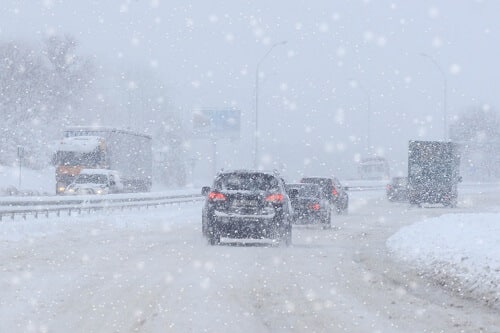
The weather in New York can vary drastically depending upon the season. Although the change in seasons brings many people joy, there can be increased consequences for those on the road. While the winter season is known for its heightened dangers caused by inclement weather, each season brings about its own challenges for drivers throughout the state.
The winter season is full of challenges for drivers in New York. In addition to low temperatures, the winter season leads to reduced daylight hours that can cause decreased visibility. Furthermore, increased traffic due to holiday travel can contribute to already treacherous conditions caused by snow, sleet, and hail. Although, the most dangerous condition facing drivers during the winter season is ice. While most drivers exercise increased caution while driving during a blizzard, the absence of a storm often lures drivers into a false sense of security. Drivers operate their vehicles as they normally would, unaware of the danger. Even light rain accompanied by freezing temperatures can cause hidden dangers such as black ice. Black ice can take unsuspecting motorists by surprise, leading to increased accidents with more severe injuries.
Springtime in New York is often a welcome change after a long, frosty winter. Although the Spring season is synonymous with increased daylight, this does not mean that the change in weather is without consequence. For many, Springtime in New York means one thing-allergies. Individuals who suffer from seasonal allergies can suffer symptoms including a runny nose, irritated eyes, and a scratchy throat. As a result, many drivers rely on over-the-counter medications to ease their allergy symptoms. However, these medications can cause increased drowsiness which can be dangerous for drivers who should be alert. Furthermore, Spring is the rainiest season, which causes decreased visibility as well as wet roads that make it harder to break at a moment’s notice. Unfortunately, after a long winter of scraping snow and ice off your windshield, many windshield wipers are worn down. Ineffective windshield wipers can make heavy rainfall even more treacherous.
For many, summertime in New York means time off from school and vacations with friends and family. However, the summer season results in the greatest number of fatal car accidents. Warmer weather leads to increased pedestrian traffic as well as bicyclists and motorcyclists on the roads. Unfortunately, this increased traffic can be deadly if drivers are not paying attention or if those walking, riding their bicycle, or motorcycle make a sudden maneuver. In addition to increased traffic on the roads, elevated temperatures can cause risks to drivers such as dehydration or heat stroke. Dehydration may manifest as dizziness, headache, and fatigue which can impair an individual’s ability to drive safely. Elevated temperatures are dangerous to the physical health of the drivers but can cause damage to numerous parts of your vehicle. Increased temperatures can cause the air in your tires to expand, resulting in a blowout for vehicles with worn-out tires. This is exceptionally dangerous as tire blowouts cause drivers to lose control of their vehicle, often resulting in severe injuries.
The foliage in New York draws many tourists to the area. However, these leaves can be hazardous for drivers. After a rainstorm, wet leaves can cause several complications such as difficulty breaking due. Furthermore, excess leaves often clog storm sewers which increases flooding on the roads. Although often overlooked, even seemingly insignificant flooding can cause severe damage. Flooding of only fifteen centimeters, a little over half an inch, can cause a driver to completely lose control of their vehicle. Flooding not only endangers the safety of the passengers of the vehicle but the vehicle itself. Driving through flooded roads can cause your breaks to fail or may flood your exhaust. Another weather condition to be aware of during the fall is fog. While fog can occur during any season, foggy conditions reach their peak during the autumn months. Even a slight haze can significantly affect your visibility by making once apparent risks harder to spot.
It is important to be aware of these potential hazards to ensure that you are driving as safely as possible, whatever the season may be. To minimize their risk, drivers should inspect their vehicles at the end of each season and make necessary repairs or bring their vehicle to be inspected by a licensed mechanic. However, the best way to avoid hazardous conditions is to listen to their local authorities and stay off the roads during inclement weather.
If you sustain an injury as the result of an accident, do not hesitate to contact our experienced Long Island car wreck attorneys. Winter, Spring, Summer, or Fall you can always call TonaLaw. Schedule a free, confidential case evaluation by calling 833-866-2529 (833-TONALAW).
SHARE
